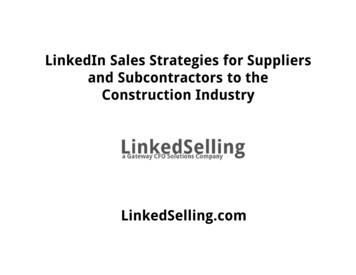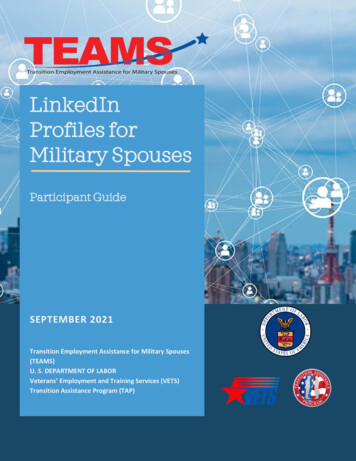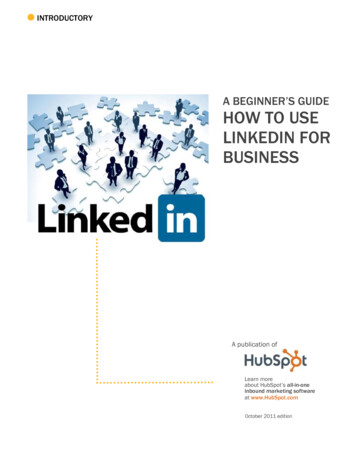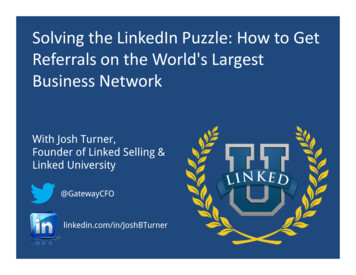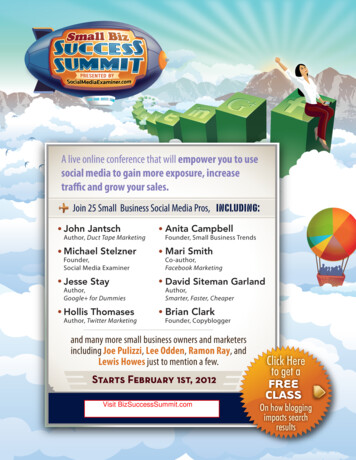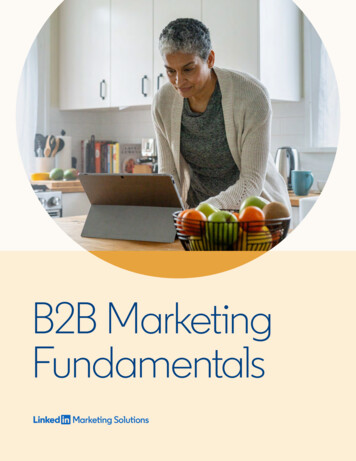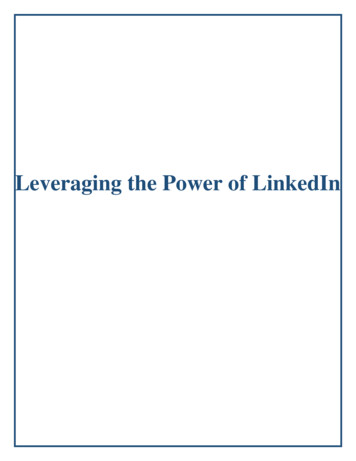
Transcription
Purpose:A practical guideHow to bring purpose to your organisationfor a competitive advantageTyrone Jacobs Jr. Electromagnetic Effects Intern at BoeingPurpose: A practical guide1
Contents1.About this guide2. What is your company’s purpose?3. Your business case for purpose4. Supply and demand in the purposetalent marketplace5. Attracting and selectingpurpose-driven talent6. C reating employee experiencesfilled with purpose7. Practical strategies to improvetalent outcomes8. Recommended reading and sources9. Authors and contributors
About this guideImagine if everyone in your workplace felt that what your companydoes really mattered – to the world, their colleagues and themselves.How much more successful would you collectively be?Earlier this year, LinkedIn and Imperative releasedthe 2016 Global Report on Purpose at Work.It explored purpose-driven talent, examining thebenefits of purpose across industry, geographyand generations.Building on the momentum of that report,this guide goes on to explore purpose-drivencompanies and how they bring meaning to work.You’ll learn practical ways to instil purpose at yourorganisation, and gain a competitive advantage intalent acquisition, engagement and management.1. About this guideAt LinkedIn we contribute to the purpose dialoguein two main ways. First, what purpose meansin the context of talent. Second, what our datasays about the issues. To compile this guide, weinterviewed dozens of purpose-driven companieson their talent strategies. We also conductedmultiple surveys with thousands of recruiters. Toround out the research, we compared samples ofover a thousand companies, five million members,almost one million jobs, and half a million hires.The learnings are all here. We hope these insightshelp you and your company on your journey.‘Companies that understandthe increasing emphasis ofpurpose in today’s professionallandscape improve their abilityto attract such employees andalso their ability to retain themfor longer periods of time.’Reid HoffmanExecutive Chairman and co-founder,LinkedInPurpose: A practical guide1
PurposeConnecting peoplewith work that matters to them,and to companies that aredriving meaningful impact.1. About this guidePurpose: A practical guide2
Purpose is a key driverof business successThe findings in this guideare essential for:1. About this guide010203Companies looking touse purpose to gain acompetitive advantage.Talent acquisition professionalslooking to find and recruitstronger candidates.Managers seeking powerfulways to engage, inspire andkeep employees.Purpose: A practical guide3
What is yourcompany’s purpose?What it means to be a purpose-driven companyDarren Walker President of Ford Foundation
Defining an experienceof purpose.Anyone can experience purpose.Purpose includes three core elements:010203Positive impacton othersPersonal growthand developmentDelivery of workthrough strong relationships2. What is your company’s purpose?Purpose: A practical guide5
Why we niesPrioritise work that mattersto them, their company andthe world – over money oradvancement.Have an aspirationalreason for being groundedin humanity that is statedand measured.Choose jobsthat offer:Create a culturethat encourages:How we work2. What is your company’s purpose?010203010203Positiveimpact Positiveimpact Purpose: A practical guide6
Some of the world’s most successfulcompanies are purpose driven:1Example purpose statementsTo draw global attention tostories that connect us.To share stories that matter,amuse, inform and inspire.To democratise accessto space for the benefitof life on earth.To create freedoms forcustomers without accessto power.Believing community extendsbeyond the places wherewe have stores.1 Note: Example companies the authors are inspired by. We have only audited some of them for compliance with the definition of a purpose company, including:IDEO, Nike, Cancer Research UK, LinkedIn, SolarCity, Southwest, Clif, GOOD, Airbnb, Fitbit, Patagonia, Cisco, and EY.2. What is your company’s purpose?Purpose: A practical guide7
Is your company purpose driven?Purpose-driven companies use the three core elements to createexceptional experiences for employees. Based on this definition,ask yourself the questions below. You can also look at Airbnb’sresponses for inspiration.QuestionWhy you workHow you work2. What is your company’s purpose?Is your reason for being grounded in humanity?For travellers to belong anywhere.Is your purpose stated and measured?Caters for 60 million guests in over34,000 cities and 191 countries.Do you have jobs or a culture that createan experience of purpose?Purposeful work is one of five pillarsof its employee experience.Do you connect employees’ work to the positiveimpact it has on others?Monthly credits enable employeesto visit listings and experience thebelonging they create.Do you encourage employees in their personaland professional development?Helps every employee be a host:authentic, humble, and focused onothers. This helps talent advance theirlives and build better relationships.Do you foster authentic relationships at work?Encourages employees to add toits culture, not fit into it. Often holdscelebrations of employee diversity.Purpose: A practical guide8
Myth bustingPurpose has exploded in the vocabulary of business.A recent report found that ‘public discourseabout “corporate/organisational purpose”has increased fivefold since 1994, and is nowtrending at an exponential rate that surpassesthe rate of public discourse about sustainability.’2With so much dialogue on this topic,it’s important to create clarity around exactlywhat purpose is – and isn’t.Here are some of the most commonmisperceptions about purpose.2 The state of the debate on purpose in business, EY Beacon Institute, 20162. What is your company’s purpose?Purpose: A practical guide9
Myth 1Purpose is just the new word for mission.Purpose is why you are in business. It isaspirational and inspiring, and its goal is tocreate a shared vision. Purpose isn’t somethingto be achieved. Purpose defines the mission,values, and culture of a company, and it hasa wider scope.Mission is what businesses do. It should bemeasurable, achievable, and aligned with purpose.Values are how an organisation makesday-to-day decisions. They are aligned withpurpose, but are not the purpose itself.Culture is the sum of these practices.When purpose, mission, and values arealigned, so is the culture.Tip: To find your company’spurpose, start with yourfounder’s story. Why did theystart the company? Most often,the answer is more than justto make money.2. What is your company’s purpose?Purpose: A practical guide10
Myth 2Purpose is the same asCorporate Social Responsibility (CSR).Purpose is the full company working towardssolving meaningful world problems. CSR andsustainability are often dedicated teams that workon specific social good or environmental effortson behalf of the company.2. What is your company’s purpose?The employee experience of CSR is oftendelivered outside of the business, throughvolunteering or by donating a percentage of timeor money. In contrast, purpose is more integratedinto every employee’s day-to-day experienceand business.Purpose: A practical guide11
Myth 3Companies that focus on profit are not purpose driven.Purpose is purely about social impact.There is no conflict between purpose and profit– particularly when profit is used to scale impact.In fact, being purpose driven brings measurablecommercial benefits.Having a positive impact on others is one of thethree core elements of a purpose experience.However, there are many ways to help others ina meaningful way. Tesla’s purpose, for example,is to accelerate the advancement of sustainabletransport. Indiegogo helps people get their passionfunded. Virgin Galactic exists to democratiseaccess to space for the benefit of life on earth.All three companies are purpose driven and forprofit at the same time. Not-for-profit or social impactcompanies are typically thought of as purposedriven – although this isn’t always the case. Kiva isa good example of a purpose-driven, non-profit,social impact company whose purpose is toconnect people through lending to alleviate poverty.Not-for-profit or social impact companies aretypically thought of as purpose driven, and oftenare. For example, Kiva is a non-profit companywhose purpose is to connect people throughlending to alleviate poverty. However, as ourdefinition describes, an aspirational reason forbeing is not enough to be a purpose company.They must also have a culture of purpose foremployees, and not all not-profits deliver that.The Millennial view3The vast majority of Millennials(95%) see no conflict betweenpurpose and wealth creation.While they feel that wealth creationis important, 75% of Millennialsalso think that businesses shouldbe more focused on helping toimprove society. Four out of fiveMillennials believe that business,rather than government, has a vitalrole to play in solving our social andenvironmental challenges.3 Mind the Gaps – The 2015 Deloitte Millennial Survey2. What is your company’s purpose?Purpose: A practical guide12
Your businesscase for purposeHow purpose gives you a competitive advantagein talent, branding and the bottom lineMark Mayungu Senior Signal Engineer
The most admired companies arefinding success at the intersectionof profit and purpose.Purpose gives youStrongertalent Strongertalentacquisition Strongertalentmanagement Strongerorganisationalstructures StrongerbrandsStronger business results3. Your business case for purposePurpose: A practical guide14
Purpose-driven professionalsare your most valuable talent.For nearly every organisation, talent is the numberone driver of success. What’s now clear is thatattracting and hiring purpose-driven professionalshas a significant business impact.LinkedIn and Imperative’s 2016 Global Report onPurpose at Work is the largest study on the roleof purpose in the workforce. Surveying 26,000LinkedIn members, it found that purpose-drivenprofessionals consistently outperform their peerswho work primarily for money or Are4 Data based on correlation between purpose and performance for 2000 employees at LinkedIn5 LinkedIn and Imperative 2016 Global Report on Purpose at Work6&7 Imperative 2015 U.S. Purpose Index study3. Your business case for purpose30%11%50%47%more likely to behigh performers4longer tenure5more likely tobe in leadershippositions6more likely to bepromoters of theiremployers7Purpose: A practical guide15
Purpose-driven companies have bettertalent outcomes.To find out how purpose influences talentacquisition and management, LinkedIn comparedGameChangers’ list of 500 purpose-drivencompanies with 500 randomly selected LinkedInmember companies matched on industry and size.Methodology8We compared talent outcomes of over onethousand companies, three million members,almost one million jobs, and half a million hires,through the lens of LinkedIn data. To doublecheck the results, we repeated the comparisonmethodology with a different list of purposecompanies, the Fit for Purpose 2015 index ofthe 100 brands best placed to put purposeinto practice.The conclusion was the same for both theGameChangers 500 and Fit for Purpose lists:Purpose brings a competitive advantageacross every stage of the career journey.8 Analysis based on 500 purpose company employees (listed in GameChanger 500 report) vs. 500 control sample company employees.The control sample companies were randomly-selected based on LinkedIn company pages matching GameChanger 500 company sizesand industries. The analysis was carried out on employee’s LinkedIn profile information as of August 2016. The analysis represents theworld seen through the lens of LinkedIn data.3. Your business case for purposePurpose: A practical guide16
Purpose-driven companies have bettertalent outcomes.Better education 43%more masters, 75% more doctorates, 200% more that studiedin a top 10 universityLinkedIn activity for 500 purpose-driven companies,compared with 500 companies matched on industryand size showed:Higher profile 117%AttractionStronger connections 117%employees with 500 connectionsMore choiceDeeperengagementaverage apply clicksand applications per jobemployees promoted companyrelevant content 29% 24%More recognised 144%inMail received, 16% more recommendations 53%more company viewsper employeeengaged with social causes3.5Xmore career pagefollowers per employeeMore hires 12%recommendations given 10%Developmentimpacted hiresMore sought-afterAwareness 27%Engagementhigher InMailacceptance rate40%more averageviews per jobApplicationHiring3. Your business case for purposePurpose: A practical guide17
Purpose-drivencompanies performedbetter at every stageof the candidate journey.3. Your business case for purposeImagine thecumulative effect ofthese improvementsfor your talent.Purpose: A practical guide18
Purpose improves organisational results.The EY Beacon Institute led purpose-minded companies todefine 5 ways you can use purpose for organisational benefits.9Organisational benefitsTake actionExamplesPurposeinstils strategic clarityUse purpose as a guide for daily decision making anda lens for long-term decision making, particularly in timesof transformation and rising expectations.Tesla decided to share itsportfolio to advance electricvehicle technology as along-term market strategy.Purposechannels innovationUse purpose to frame creativity and innovation and maintainfocus on customer needs (rather than on a product).Dove’s purpose: to makeevery woman in the world feelcomfortable with her appearancerather than sell more soap.Revenue grew from 2.4b to 4bin last decade.Purposetaps a universal needUse purpose to motivate and unite a diverse teamthrough a common desire to contribute to a meaningful goal.Procter & Gamble’s former CMOJim Stengal found that purpose‘unifies R&D and engineering andmarketing and sales and everyonearound the difference they aretrying to make.’Purposeis a response to transformationKeep purpose at the forefront of transformation to help peopleunderstand the long-term context of short-term changes –and to ensure the focus of change is positive and inspiring.Bupa Arabia realised its purposewas more about healthcare thaninsurance, helping the companygrow from 50k customers in 2013to 750k in 2014.Purposebuilds bridgesIn the context of a commercial collaboration such asjoint ventures or mergers and acquisitions, a clearly statedpurpose can help demonstrate cultural alignment betweenpotential partners.Due to purpose, Unilever’s CEOfound that ‘more suppliers wantto work with us now becauseit energises their employees andbusiness models as well.’9 The state of the debate on purpose in business, EY Beacon Institute, 2016.3. Your business case for purposePurpose: A practical guide19
Purpose builds strongerconsumer brands.In study of over 7,000 consumers published inthe Harvard Business Review, 64% of consumerssaid that shared values are the primary reasonthey have a relationship with a brand10 –making values by far the largest driver of brandrelationships.This preference impacts on purchasing behaviour.A separate study found that 80% of consumerswould rather pay more for products and servicesthat are produced responsibly11. Globally, 89% ofconsumers have said there is a strong likelihoodthey would buy from companies that supportsolutions to particular social issues – and purposeas a reason to buy rose 26% between 2008 and2012.12Boston consulting company Brighthouse has tipsto use purpose to transform a brand into a stand:Brand Purpose StandA brandA standWhatWhyPoint ofdifferencePoint ofviewMarket drivenEthically onsumersAdvocatesAdsActionsNext quarterNext quartercenturyLoyaltyLove“ The brands that will thrive in thecoming years are the ones thathave a purpose beyond profit.” 13Richard Branson“ A brand is not so much aboutrational arguments, but the waythat the company resonates withpeople emotionally. Marketing isabout values.” 14Steve Jobs10 hbr.org/2012/05/three-myths-about-customer-eng11 Trust and Purpose Survey 2011, Burson-Marsteller, 201112 The 2012 goodpurpose study, Edelman annual global research13 nson-guy-kawasaki-talk-branding14 nson-guy-kawasaki-talk-branding3. Your business case for purposePurpose: A practical guide20
The combined advantagesof purpose drive profit.Leading with purpose encourages strongerperformance across brands, talent andorganisational agility. The result is measurablebusiness impact.87% percent of executives believe they performbest over time if purpose goes beyond profit,15and this perception is backed up by results.Research from the EY Beacon Institute andHarvard Business School shows that companiesthat lead with purpose are more likely to beprofitable.% of non-purposeled companies thatshowed drop in revenue42%% of purpose-ledcompanies thatshowed positive growth85%58%of companies with aclearly articulatedand understoodpurpose experiencedgrowth of 10%vs42%of companies notprioritising purpose1615&16 The state of the debate on purpose in business, EY Beacon Institute, 20163. Your business case for purposePurpose: A practical guide21
Supply and demandin the purposetalent marketplaceChristopher Fonseca Deaf Dance Teacher
Purpose-driven companiesare in demand.Talent places a higher value on purpose-drivencompanies. Yet there are a limited numberof companies that are purpose-led. Thiscombination of high demand and limited supplygives purpose-driven companies a doubleadvantage in the talent marketplace.In a recent LinkedIn survey, nearly half said theywould consider taking a job with lower pay if itmeant they could work for a company that makesa positive impact on people’s lives and society.20%19%would trade1-5%of their salarywould trade5-20%of their salary10%would trade20-100%of their salary49%A total of 49% wouldtrade a portion of theirsalary for purpose.17Purpose-led companies don’t pay lessfor their talent. They attract better talentwith the same salary.While purpose-driven professionals arewilling to sacrifice salary for purpose, theydon’t have to. Imperative’s 2015 WorkforcePurpose Index found that purpose-drivenprofessionals have similar salaries to theirnon-purpose peers.18In addition, our fulfilment survey showedno correlation between the salaryprofessionals are willing to give up to workin a purpose-driven environment, and theirincome level. In other words, purposeisn’t something that only highly paidprofessionals ‘buy’.17 LinkedIn Fulfillment Study 2016 – survey conducted among 3,000 professionals and 500 recruiters/HR professionals in the UK in July18 Imperative 2015 U.S. Purpose Index study4. Supply and demand in the purpose talent marketplacePurpose: A practical guide23
Talent believes there is a limitedsupply of purpose-driven companies.Purpose-driven companiesare sought-after employers.However, professionals believethat only a third of the companiesthat they would consider workingfor can offer an experience ofpurpose at work.19In a survey of over 600 LinkedInmembers, 16% of respondentssaid that the main barrier tothem pursuing a more rewardingcareer is an inability to findan employer whose purposematches their own.2019&20 Results from February 2016 Omnibus survey of U.S. professionals.4. Supply and demand in the purpose talent marketplacePurpose: A practical guide24
There is demand amongst recruitersfor purpose-driven talent.Recruiters believe a sense of purpose increasesa candidate’s value. They see a strong advantagein hiring candidates that share a company’s values,mission or purpose:69%say these employeesare more fulfilledin their job.67%say these employeesare more likely to stay withthe company for longer.21&22 LinkedIn Fulfillment Study 2016 – survey conducted among 3,000 professionals and 500 recruiters/HR professionals in the UK in July4. Supply and demand in the purpose talent marketplace53%say these employeesare better performersat their jobs.4%don’t think that there are anybusiness advantages of hiringemployees that share thecompany’s values, missionor purpose.21With purpose-driven professionals reporting 64%higher fulfilment in their work, recruiters recognisethat this has commercial benefits: 82% believefulfilled employees are more productive.22Purpose: A practical guide25
However, there is a limited supplyof purpose-driven professionals.Representing just 37% of professionals, purposedriven people are still the minority. As the value ofa purpose-oriented talent becomes more evident,there will be more and more competition for thissegment of the workforce.Millennials(18-35)Community andSocial ServicesEntrepreneurshipGen X(36-50)It’s interesting to note that purpose is not onlyowned by Millennials. Percentages of purposeorientation actually increase across generationgroups, with baby boomers leading the way.EducationBabyBoomers(51 )For a full review of the supply of purpose-driventalent see the LinkedIn and Imperative 2016Global Report on Purpose at Work48%38%Healthcare ServicesResearch54%51%49%43%41%30%Percentage of generationwho are purpose oriented23Top 5 most purpose-orientedjob functions2423&24 LinkedIn and Imperative 2016 Global Report on Purpose at Work4. Supply and demand in the purpose talent marketplacePurpose: A practical guide26
Attracting and selectingpurpose-driven talentDanish Ahmed Co-Founder at PLAYGround Digital
When asked the question: ‘Why work for us’,successful companies are answering with purpose.Purpose-focused employment branding is a powerful tool.Here’s how you can use it to attract better talent.Communicateyour purpose.91% of recruiters consider having aclear set of values, mission or purpose tobe an important factor when attracting thebest talent.2552% of candidates say they wouldn’taccept a job offer if they didn’t know ordidn’t agree with a company’s mission,values and purpose.26Highlight purposefor all generations,including Millennials.“ Today’s Millennials arejust as interested in howa business develops itspeople and its contributionto society as they are in itsproducts and profits.” 27Barry Salzberg,CEO of Deloitte GlobalShow how your companydelivers the three core elementsof an experience of purpose.01Impact on others –how your company makesthe world a better place02Personal development –the opportunities you providefor personal growth03Delivery through relationships –how you encourage authenticrelationships at work25&26 LinkedIn Fulfillment Study 2016 - survey conducted among 3,000 professionals and 500 recruiters/HR professionals in the UK in July27 Mind the Gaps – The 2015 Deloitte Millennial Survey5. Attracting and selecting purpose-driven talentPurpose: A practical guide28
Examples of purpose-focused employment branding:Welcome aboard the flight of your life.Not just a career, a cause.At Southwest Airlines we connect People towhat’s important in their lives—that also meansconnecting our Employees to what’s important intheir lives! Our Employees value the opportunity towork hard, be creative, and have fun on the job.Southwest frames its purpose by highlightinghow it connects people and employees tothe things that matter to them. It also clearlyencourages strong relationships at work.Notice the purpose language of ‘not justa career a cause’.5. Attracting and selecting purpose-driven talentPurpose: A practical guide29
Take a purpose-focused approachto talent interviews and selection.Purpose-driven companies get more followersand job applications. With a greater choice of talent,the key challenge for these companies is inselecting the most purpose-driven professionals.To use purpose in your selection:85%63%Provide realistic job previews about howother employees experience purpose atwork (see GOOD portrait, which exploreshow the company selects employeeslooking for macro-level purpose impact)of recruiters check whethercandidates understand and agreewith the organisation’s values, missionor purpose during interviews.28of recruiters would excludeotherwise suitable candidatesfrom the hiring process if theydidn’t agree with the organisation’svalues, mission or purpose.29 Invest in training hiring managers28&29 LinkedIn Fulfillment Study 2016 – survey conducted among 3,000 professionals and 500 recruiters/HR professionals in the UK in July5. Attracting and selecting purpose-driven talentPurpose: A practical guide30
The best questionto screen for purpose:‘What motivates you at work?’Hiring managers believe that when it comes totalent selection, soft skills (such as behaviouralqualities and personality traits), are harder to findthan hard skills (such as those learned in training).30They believe the best way to assess a candidate’ssoft skills is through interview questions.Hiring managers believe the bestquestions to screen for purpose are:1“What motivates you at work?”2“What aspects of your workmake you feel best?What makes you feel mostuseful or happy?”3“Think about a time whenyou adjusted the work you doto have more of a positive impact.What did you do? What didyou want to accomplish?”30 LinkedIn May 2016 survey of 1,297 hiring managers in the US, Canada, UK Netherlands, Australia and India.5. Attracting and selecting purpose-driven talentPurpose: A practical guide31
Example of purpose-focused selection:Southwest employees are purpose-driven, andthe company has very high hiring standards toprotect that culture.In a biennial survey, Southwest employees wereasked if they feel like their role is ‘just a job’,‘a stepping stone’, or ‘a calling’. Nearly 75% ofemployees felt their role is ‘a calling’.“ Southwest doesn’t just hire for a goodattitude and train for skill. It hires for a very,very specific attitude, often interviewing over100 people for a single role.”In 2015, Southwest received 371,202 CVs andhired nearly 6,000 new employees. To ensureselection for purpose alignment is possible, thecompany often interviews more than 100 peopleto fill a single position.5. Attracting and selecting purpose-driven talentPurpose: A practical guide32
Using LinkedIn to leverageyour company’s purpose.LinkedIn’s tools can help you showcase your company’s purpose,and find and select purpose-driven talent.To attractpurpose-driven talentTo selectpurpose-driven talentLinkedIn Career PagesLinkedIn ReferralsLinkedIn RecruiterLinkedIn Jobs5. Attracting and selecting purpose-driven talentPurpose: A practical guide33
Showcase your purposewith LinkedIn Career Pages.To help talent make the connection between your companyand its purpose, consider using LinkedIn Career Pages:1Communicate your experience of purposemore directly. Consider creating targeted viewsfocusing on your company’s experience ofpurpose.2Use hero images, copy and video thatshowcase your purpose and brand in anengaging and inspiring way.3Encourage employees to share theirexperience of purpose. Employee voice isthe most trusted source of information. Askemployees to share their experiences of purposeat work through photos and posts.45. Attracting and selecting purpose-driven talentShowcase the causes that matter to youremployees. Use the automated companyinsights to showcase the causes your employeescare about and the organisations they support.1234Purpose: A practical guide34
LinkedIn Referrals are a powerful wayto recruit purpose-driven professionals.In the talent marketplace, referrals are the numberone source of quality hires, requiring less timeto recruit and having a longer tenure. ThroughLinkedIn Referrals, employees can introducecandidates that share the company’s senseof purpose.While it can be hard to detect purpose on a CV,purpose-driven professionals are likely to knoweach other or network together. They reportdeeper relationships, and are 117% more likely tohave 500 connections31. Additionally, purposeoriented talent is 47% more likely32 to promotetheir employer, making it easier to get referrals.31 Analysis based on 500 purpose company employees (listed in GameChanger 500 report) vs. 500 control sample company employees.The control sample companies were randomly selected based on LinkedIn company pages matching GameChanger 500 company sizes andindustries. The analysis was carried out on employee connections from their LinkedIn profile as of August 2016. The analysis represents the worldseen through the lens of LinkedIn data.32 Imperative 2015 U.S. Purpose Index study5. Attracting and selecting purpose-driven talentPurpose: A practical guide35
Use LinkedIn Recruiter andJobs to improve talent selection.When it comes to job seeking, 69% of purposeoriented employees are passive, versus 61% oftheir non-purpose peers.33 LinkedIn Recruiter,which helps you connect with passive talent, isone of the best tools to help you find purposedriven talent.The top three factors that entice purpose-orientedpeople to accept a new job are:To attract purpose-oriented professionals, focusmore on these factors, and less on factors likeadvancement, rewards or titles.LinkedIn and Imperative’s 2016 Global Reporton Purpose at Work will help you to target theindustries, job types and locations with the mostpurpose-driven talent.01 Culture and values02 Mission and vision03 Products and servicesLinkedIn members are significantlymore purpose-driven. 40% of U.S.professionals on LinkedIn are purposedriven, compared with 28% of thegeneral workforce.3433&34 LinkedIn and Imperative 2016 Global Report on Purpose at Work5. Attracting and selecting purpose-driven talentPurpose: A practical guide36
Creating employeeexperiences filledwith purposeFlorent Groberg
Purpose-driven professionals are your most valuable talent. 4 Data based on correlation between purpose and performance for 2000 employees at LinkedIn 5 LinkedIn and Imperative 2016 Global Report on Purpose at Work 6&7 Imperative 2015 U.S. Purpose Index study 3. Your business case for purpose 30 % 11 % 50 % 47 % P
